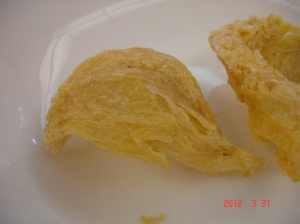Cooking with Alison’s Mom (Part 6)
Dried birds’ nests (also known as swallows’ nests) are considered a Chinese delicacy. Bird’s nests are believed to have many health benefits, including improving overall health and combating signs of aging. There are 3 different types of bird’s nest and they can be distinguished by their differing colours. The colours are, in order of increasing price, white, yellow (shown in the photos below), and red. Some people say that drinking a few spoonfuls of birds’ nest each day will keep you looking young and feeling healthy.
Bird’s nest is most commonly used to make a Chinese sweet dessert soup. After being boiled, bird’s nest becomes gelatinous in texture. It is pretty much flavourless. Here is my mom’s simple recipe for bird’s nest soup. Alternatively, we also make the birds’ nest without the rock sugar and then mix a few spoonfuls of it into a bowl of warm milk. I love drinking it with milk just before bed.












